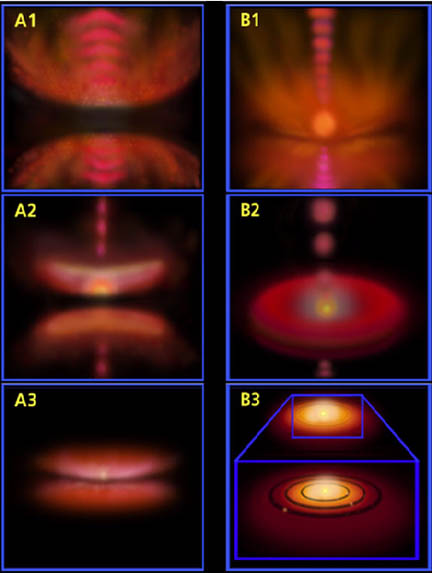
|
Textbook drawings show protoplanetary disks (disks of dust and gas that are ready to give birth to planets) from close range and with ideal lighting. Unfortunately, as with the vast cold molecular clouds that give birth to star systems, protoplanetary disks are too cold to give off much light. Moreover, the central star is so much brighter than the disk that its glare tends to mask any disk present. So what do we look for? A good situation is to see a disk from the edge (side view) when it is still very young (A1 above). The dust and gas in the disk hide most of the light from the central star. The areas above and below the disk have so little dust that starlight floods out and lights up broad areas of diffuse dust above and below the dark band. Also, recall that jets of material shoot out along the rotational axis of a star as long as plenty of material is still falling in toward the growing star. A fat jet is shown in A1. A2 shows the same disk some time later: the disk has thinned as more material reaches the central star or becomes concentrated within the disk. Enough material is still infalling that the jets are still prominent. A3 shows a very thin disk. The star is about to become visible and so little material is falling toward the baby star that the jets have shut down. B1 through B3 show the same steps, but with a view more from above. This vantage point makes it harder to spot the dark band that marks the disk, but B3 shows that there is a potential of spotting dark circles within the disk. These dark bands are where the gravitational fields of developing planets are vacuuming up all of the dust and clutter in their orbits. In this view from above, the disk is lit by the star and the dark bands mark the absence of matter. There are images that hint at such dust-free bands, but I won't show them. Search the Hubble site under 'protoplanetary disks' (and not planetary nebula, which have nothing to do with planets!). Next Image: Do we see protoplanetary disks?Image credit: Hubble Space Telescope; The main source for HST images and explanations is HubbleSite.org. |
|
|
|
